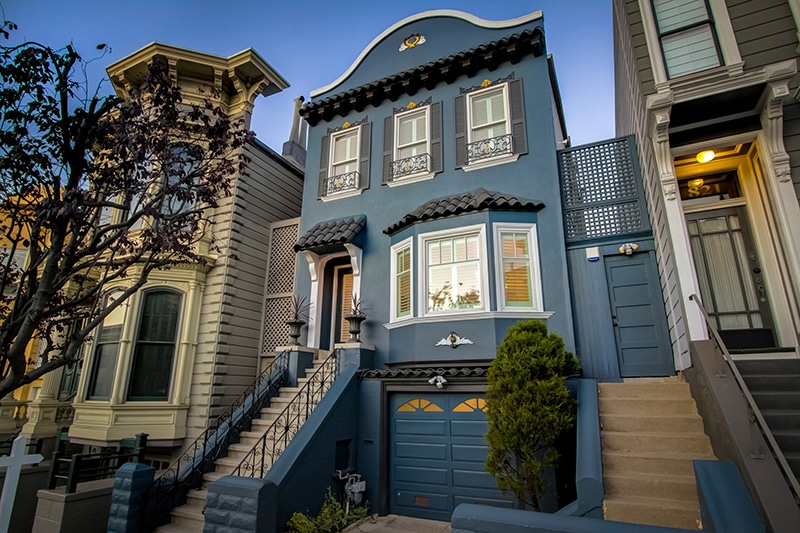A century-old church carefully converted into a contemporary home has hit the market in the NSW town of Robertson.
The six-bedroom house at 39 Hoddle Street, Robertson has been listed for sale, with a price guide of $2.5-2.7 million.
Owner, designer and artist Josette Cauchi bought the church, first constructed in 1902, on Robertson’s main street in 2017 after spotting it in a magazine.
“I’ve always loved big, open spaces,” Ms Cauchi said.
“I’d lived in two converted warehouses in Sydney, so when I saw this place with its lawns, the hall and the church together, I thought, I can make this work.
The Hoddle Street church was first constructed in 1902. Picture: realestate.com.au/buy
“There was absolutely nothing inside - just a shell. No kitchen, no bathroom, two toilets outside. So I bought a camping shower and oven and moved in.”
Having long worked in hospitality and interior design, Ms Cauchi arrived with plans already sketched and had an architect formalise them - a pragmatic move that kept the process quick and costs down.
Soaring double-height ceilings and crisp white walls frame the open-plan living zone. Picture: realestate.com.au/buy
Council approval came within six months; with everything pre-ordered, trades started immediately and finished the old church hall first as her private quarters.
“I then added two extensions - a bathroom and a studio - following the original lines and mimicked everything so to this day, you can’t tell where the new starts and the old ends,” she said.
Josette Cauchi converting the Robertson church. Picture: Supplied
“I’m an artist - I like stepping outside the lines.”
She tackled decades of orange varnish and tired finishes with a mix of pragmatism and flair.
Before and after the conversion at 39 Hoddle Street, Robertson. Picture: Supplied
“I felt like I was in a 1980s sauna, so I stripped the floorboards and stained them Japanese black,” she said.
“We also found a primer that grips to old oil varnish, so I could paint the church without sanding the whole thing - saving weeks and a lot of money.”
A well-equipped kitchen anchors the home. Picture: realestate.com.au/buy
“I like blending the new with the old - a bit of New York industrial with vintage touches.”
Building challenges and creative fixes
The biggest design puzzle of the project became a signature move.
The interiors were given a complete makeover during the conversion. Picture: Supplied
“The real problem with church conversions is where to put bathrooms - you don’t want a square box in front of a beautiful space,” Ms Cauchi said.
“It took me two months to come up with an angled bathroom in the middle to separate bedroom and living. The architects loved it and added an angled roof. It became a sculptural piece.”
Design schools now bring students to study her inventive approach to adaptive reuse.
Bringing the structure up to modern standards was just as considered: a new sewer line, full rewiring and upgraded switchboards, and the original timber proved robust enough to carry a glass mezzanine without extra posts.
The conversion features a mezzanine retreat overlooking the open-plan living zone. Picture: realestate.com.au/buy
Ms Cauchi was frank about the nuts and bolts of the project, noting that checking the zoning was a priority.
The Hoddle Street church has a mixed-use category that allows both residence and business.
The central bathroom showcases indulgent design, with a striking freestanding bath framed by a cathedral-style window. Picture: realestate.com.au/buy
“It’s an advantage because you can live and run something from the same address, but banks usually only lend about 60% on a property like that; a standard residential loan might give you 90-95%, so you’ll need a bigger deposit,” she said.
“With churches, you often need to add a kitchen and a bathroom, think $30,000 - so you can live there while you stage the rest.”
The 2,023sqm property is positioned in the heart of Robertson. Picture: realestate.com.au/buy
Ms Cauchi said renovators should live in the property first to watch where the sun falls, find your favourite nooks, and then commit.
“I spent more on the renovations and garden than I did on the church,” she said. “But you do it a bit at a time.”
A vintage photo of the Robertson church. Picture: Supplied
A home with heart
Now complete, the half-acre estate feels both grand and grounded: six bedrooms, six bathrooms, a mudroom and five bi-fold doors that open to a large deck and edible garden planted with figs, walnuts and citrus.
“I designed it for entertaining,” she said. “I created a holiday destination for all my friends.”
Since moving to the town, Robertson has blossomed into what she calls “the jewel of the Highlands” - a foodie pocket where city visitors now come for wood-fired pizza, artisan cheese and slow-cooked wagyu pies.
For those dreaming of buying their own deconsecrated church, Ms Cauchi’s advice is simple: be respectful, be creative, and stay practical.
“You want to keep the essence and to continue the original look - that’s where the value is,” she said.
“A church commands respect in its renovations. If you do it well, you’ll end up with something truly unique. Take your time.”
After eight years, her sanctuary in Robertson is ready for its next custodian.
This five-bedroom church conversion at 69 Falcon Street, Crows Nest is on the market. Picture: realestate.com.au/buy
“I’ve loved every minute here,” she said. “It’s been beautiful, inspiring and full of life.”
So what’s next for Ms Cauchi?
She’s ticking off the last two items on her bucket list, which are to live with absolute water views and to live in Italy - and she’s already found the place with the view.



















 English (US) ·
English (US) ·